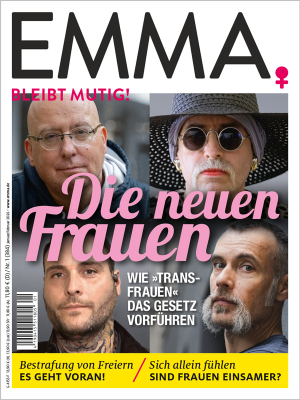Feminist Europe, Book Review: Always
That would explain the origin of her beautiful relationship with this paper. But how did the Countess and Alice Schwarzer meet? It was in 1987 that EMMA-editor Schwarzer asked her great role model ("without this single female name in the first ranks of political journalism I would probably not have been able to imagine myself as a future Journalist") for an interview. So the Countess, always curious, dropped in at the feminist Studio in Cologne - "you have a nice place here" - and a portrait was published with the apt title "The Chieftain" [der Häuptling]. "Truthfully," Dönhoff (She died in 2002) wrote to Schwarzer later, "no member of my family has ever been portrayed with such kindness and with such an Investment in research and precision - the fact that it is about me touches me most deeply. For actually, I do not deserve that much consideration - least of all in the house of feminism." And why not?
In any case, Alice Schwarzer plucks up her courage a few years later and makes the Countess an offer. The offer to write her biography. Schwarzer, herseif a woman who bursts all bonds of convention, wants to understand "what [Dönhoff s] material is woven of, where she got the courage for resis-tance and the strength to take responsibility. What are the roots of this sensitive rationality, this sensible presumptuousness, this high-minded modesty?"
Marion Dönhoff says yes. She trusts and respects her intelligent colleague. Thus begins a - shall we say tension-filled - collaboration between the two unlike women, "a year of affection and anger, of understanding and falling silent," in the biographer's words.
In conversations with the Count's large family clan, with the family of DIE ZEIT, with friends of both genders and with proteges, the experienced Journalist tries to get close to her subject. For example, Richard von Weizsäcker [long-time CDU member of the German parliament and President of Germany 1984-94, trans. note] answers a question about the role played by Marion Dönhoff within the circle of like-minded colleagues: "She was the ringleader of us younger ones - though we were actually not so young any more; we had after all borne responsibility during the war. But she was the one who asked: What are your plans now? What do you intend to do? That was no different in 1945 than in 1995." Or her favorite nephew Hermann Harzfeldt (the countess helped to bring up the orphaned child, who as an adult was her confidant and traveling companion for many years) comments wittily about his part: "I had the role of the wife, so to speak." Among the most important sources are books by the Countess herseif, such as Childhood in East Prussia [Kindheit in Ostpreußen] and the moving volume For the Sake ofHonor [Um der Ehre willen], about her murdered friends of the 20* of July, 1944 [failed attempt on Hitler's life, trans. note].
Alice Schwarzer ends the biography with a collection of Marion Dönhoff s articles under the title "Democracy and Responsibility" that make clear what has always moved her - and does today more than ever. Is your curiosity aroused? Rightly so.
by Marqrit Gerste; Trans. Jeanette Clausen, Feminist Europe 2008. - Review of Schwarzer, Alice: "Marion Dönhoff. Ein widerständiges Leben." [Marion Dönhoff. A Resistant Life] Kiepenheuer & Witsch, 1996. - Review originally appeared in Die Zeit, 13/1996.



































































































